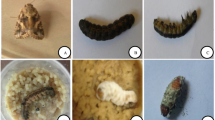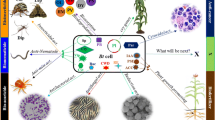Abstract
Mdj1 is a member of the Hsp40 family containing a DnaJ or J domain. Here, we have examined the functions of an Mdj1 orthologue (56.68 kDa) in Beauveria bassiana, a filamentous fungal insect pathogen widely applied in biological control of insect pests. Deletion of mdj1 in B. bassiana resulted in significant growth defects on a variety of complex and minimal media. The Δmdj1 mutant exhibited not only a drastic reduction (92 %) in aerial conidiation during optimal cultivation but also a remarkable decrease (77 %) in submerged blastospore production. Compared to wild-type, the deletion mutant was significantly more sensitive to the stresses of cell wall perturbation, high osmolarity, oxidation, carbendazim fungicide, several metal ions, and acidic/alkaline pH during conidial germination and/or colony growth. In the mutant, conidial thermotolerance and UV-B resistance decreased by 61 and 25 %, respectively, and virulence to Galleria mellonella larvae was largely attenuated. Transcript levels of many phenotype-related genes were drastically suppressed in the absence of mdj1, accompanied with impaired cell walls and reduced intracellular anti-stress molecules, including superoxide dismutases, catalases, glycerol, trehalose, and mannitol. These data indicate that Mdj1 plays a vital role in normal fungal development and contributes significantly to the biological control potential of B. bassiana against insect pests.




Similar content being viewed by others
References
Alves FD, Stevenson A, Baxter E, Gillion JLM, Hejazi F, Hayes S, Morrison IEG, Prior BA, McGenity TJ, Rangel DEN (2015) Concomitant osmotic and chaotropicity-induced stresses in Aspergillus wentii: compatible solutes determine the biotic window. Curr Genet 61:457–477
Batista WL, Matsuo AL, Ganiko L, Barros TF, Veiga TR, Freymüller E, Puccia R (2006) The PbMDJ1 gene belongs to a conserved MDJ1/LON locus in thermodimorphic pathogenic fungi and encodes a heat shock protein that localizes to both the mitochondria and cell wall of Paracoccidioides brasiliensis. Eukaryot Cell 5:379–390
Cheetham ME, Caplan AJ (1998) Structure, function and evolution of DnaJ: conservation and adaptation of chaperone function. Cell Stress Chaperon 3:28–36
Ciesielski GL, Plotka M, Manicki M, Schilke BA, Dutkiewicz R, Sahi C, Marszalek J, Craig EA (2013) Nucleoid localization of Hsp40 Mdj1 is important for its function in maintenance of mitochondrial DNA. BBA-Mol Cell Res 1833:2233–2243
Dourado BZ, Batista WL, Longo LVG, Mortara RA, Puccia R (2014) Dual localization of Mdj1 in pathogenic fungi varies with growth temperature. Med Mycol 52:1–9
Duchniewicz M, Germaniuk A, Westermann B, Neupert W, Schwarz E, Marszalek J (1999) Dual role of the mitochondrial chaperone Mdj1p in inheritance of mitochondrial DNA in yeast. Mol Cell Biol 19:8201–8210
Dulermo T, Rascle C, Blilon-Grand G, Gout E, Bligny R, Cotton P (2010) Novel insights into mannitol metabolism in the fungal plant pathogen Botrytis cinerea. Biochem J 427:323–332
Elbein AD, Pan YT, Pastuszak I, Carroll D (2003) New insights on trehalose: a multifunctional molecule. Glycobiology 13:17R–27R
Etxebeste O, Garzia A, Espeso EA, Ugalde U (2010) Aspergillus nidulans asexual development: making the most of cellular modules. Trends Microbiol 18:569–576
Fang WG, Zhang YJ, Yang XY, Zheng XL, Duan H, Li Y, Pei Y (2004) Agrobacterium tumefaciens-mediated transformation of Beauveria bassiana using an herbicide resistance gene as a selection marker. J Invertebr Pathol 85:18–24
Greene MK, Maskos K, Landry DJ (1998) Role of the J-domain in the cooperation of Hsp40 with Hsp70. Proc Natl Acad Sci U S A 95:6108–6113
Leidig C, Bange G, Kopp J, Amlacher S, Aravind A, Wickles S, Witte G, Hurt E, Beckmann R, Sinning I (2013) Structural characterization of a eukaryotic chaperone-the ribosome-associated complex. Nat Struct Mol Biol 20:23–U34
Lewis MW, Robalino IV, Keyhani NO (2009) Uptake of the fluorescent probe FM4–64 by hyphae and haemolymph-derived in vivo hyphal bodies of the entomopathogenic fungus Beauveria bassiana. Microbiol-UK 155:3110–3120
Li F, Shi HQ, Ying SH, Feng MG (2015) Distinct contributions of one Fe- and two Cu/Zn-cofactored superoxide dismutases to antioxidation, UV tolerance and virulence of Beauveria bassiana. Fungal Genet Biol 81:160–171
Lim JG, Lee JG, Kim JM, Park JA, Park SM, Yang MS, Kim DH (2010) A DnaJ-like homolog from Cryphonectria parasitica is not responsive to hypoviral infection but is important for fungal growth in both wild-type and hypovirulent strains. Mol Cells 30:235–243
Lindquist S (1986) The heat-shock response. Annu Rev Biochem 55:1151–1191
Lisse T, Schwarz E (2000) Functional specificity of the mitochondrial DnaJ protein, Mdj1p, in Saccharomyces cerevisiae. Mol Gen Genet 263:527–534
Liu Q, Ying SH, Feng MG, Jiang XH (2009) Physiological implication of intracellular trehalose and mannitol changes in response of entomopathogenic fungus Beauveria bassiana to thermal stress. Antonie Van Leeuwenhoek 95:65–75
Livak KJ, Schmittgen TD (2001) Analysis of relative gene expression data using real-time quantitative PCR and the 2−ΔΔCt method. Methods 25:402–408
Palecek SP, Parikh AS, Kron SJ (2002) Sensing, signalling and integrating physical processes during Saccharomyces cerevisiae invasive and filamentous growth. Microbiol-UK 148:893–907
Park HS, Yu JH (2012) Genetic control of asexual sporulation in filamentous fungi. Curr Opin Microbiol 15:669–677
Prip-Buus C, Westermann B, Schmitt M, Langer T, Neupert W, Schwarz E (1996) Role of the mitochondrial DnaJ homologue, Mdj1p, in the prevention of heat-induced protein aggregation. FEBS Lett 380:142–146
Rispail N, Soanes DM, Ant C, Czajkowski R, Grünler A, Huguet R, Perez-Nadales E, Poli A, Sartorel E, Valiante V, Yang M, Beffa R, Brakhage AA, Gowi NAR, Kahmann R, Lebrun MH, Lenasi H, Perez-Martin J, Talbot NJ, Wendland J, Di Pietro A (2009) Comparative genomics of MAP kinase and calcium-calcineurin signaling components in plant and human pathogenic fungi. Fungal Genet Biol 46:287–298
Rowley N, Prip-Buus C, Westermann B, Brown C, Schwarz E, Barrell B, Neupert W (1994) Mdj1p, a novel chaperone of the DnaJ family, is involved in mitochondrial biogenesis and protein folding. Cell 77:249–259
Szabo A, Korszun R, Hartl FU, Flanagan J (1996) A zinc finger-like domain of the molecular chaperone DnaJ is involved in binding to denatured protein substrates. EMBO J 15:408–417
Tamura K, Peterson D, Peterson N, Stecher G, Nei M, Kumar S (2011) MEGA5: molecular evolutionary genetics analysis using maximum likelihood, evolutionary distance, and maximum parsimony methods. Mol Biol Evol 28:2731–2739
Tang W, Wang CC (2001) Zinc fingers and thiol-disulfide oxidoreductase activities of chaperone DnaJ. Biochemistry 40:14985–14994
Van Dyck L, Langer T (1999) ATP-dependent proteases controlling mitochondrial function in the yeast Saccharomyces cerevisiae. Cell Mol Life Sci 56:825–842
Vjestica A, Zhang D, Liu JH, Oliferenko S (2013) Hsp70-Hsp40 chaperone complex functions in controlling polarized growth by repressing Hsf1-driven heat stress-associated transcription. PLoS Genet 9:e1003886
Voos W, Röttgers K (2002) Molecular chaperones as essential mediators of mitochondrial biogenesis. Biochim Biophys Acta 1592:51–62
Wall D, Zylicz M, Georgopoulos C (1994) The NH2-terminal 108 amino acids of the Escherichia coli DnaJ protein stimulate the ATPase activity of DnaK and are sufficient for λ replication. J Biol Chem 269:5446–5451
Walsh P, Bursac D, Law YC, Cyr D, Lithgow T (2004) The J-protein family: modulating protein assembly, disassembly and translocation. EMBO J 5:567–571
Wanchoo A, Lewis MW, Keyhani NO (2009) Lectin mapping reveals stage-specific display of surface carbohydrates in vitro and haemolymph-derived cells of the entomopathogenic fungus Beauveria bassiana. Microbiol-UK 155:3121–3133
Wang CS, Feng MG (2014) Advances in fundamental and applied studies in China of fungal biocontrol agents for use against arthropod pests. Biol Control 68:129–135
Wang J, Zhou G, Ying SH, Feng MG (2013a) P-type calcium ATPase functions as a core regulator of Beauveria bassiana growth, conidiation and responses to multiple stressful stimuli through cross-talk with signalling networks. Environ Microbiol 15:967–979
Wang ZL, Zhang LB, Ying SH, Feng MG (2013b) Catalases play differentiated roles in the adaptation of a fungal entomopathogen to environmental stresses. Environ Microbiol 15:409–418
Wang J, Ying SH, Hu Y, Feng MG (2016) Mas5, a homologue of bacterial DnaJ, is indispensable for the host infection and environmental adaptation of a filamentous fungal insect pathogen. Environ Microbiol 18:1037–1047
Xiao GH, Ying SH, Zheng P, Wang ZL, Zhang SW, Xie XQ, Shang YF, Zheng HJ, Zhou Y, St Leger RJ, Zhao GP, Wang CS, Feng MG (2012) Genomic perspectives on the evolution of fungal entomopathogenicity in Beauveria bassiana. Sci Rep UK 2:483
Xie XQ, Li F, Ying SH, Feng MG (2012) Additive contributions of two manganese-cored superoxide dismutases (MnSODs) to antioxidation, UV tolerance and virulence of Beauveria bassiana. PLoS One 7:e30298
Zeng FY, Gong XY, Hamid MI, Fu YP, Xie JT, Cheng JS, Li GP, Jiang DH (2012) A fungal cell wall integrity-associated MAP kinase cascade in Coniothyrium minitans is required for conidiation and mycoparasitism. Fungal Genet Biol 49:347–357
Zhang YJ, Zhao JH, Fang WG, Zhang JP, Luo ZB, Zhang M, Fan YH, Pei Y (2009) Mitogen-activated protein kinase hog1 in the entomopathogenic fungus Beauveria bassiana regulates environmental stress responses and virulence to insects. Appl Environ Microbiol 75:3787–3795
Zhang SZ, Xia YX, Kim B, Keyhani NO (2011) Two hydrophobins are involved in fungal spore coat rodlet layer assembly and each play distinct roles in surface interactions, development and pathogenesis in the entomopathogenic fungus, Beauveria bassiana. Mol Microbiol 80:811–826
Zhang L, Wang J, Xie XQ, Keyhani NO, Feng MG, Ying SH (2013) The autophagy gene BbATG5, involved in the formation of the autophagosome, contributes to cell differentiation and growth but is dispensable for pathogenesis in the entomopathogenic fungus Beauveria bassiana. Microbiol-UK 159:243–252
Acknowledgments
We thank Jun-Ying Li (Analysis Center of Agrobiology and Environmental Sciences, Zhejiang University) for the technical assistance with TEM. This work was supported by the National Natural Science Foundation of China (Grants 31270537, 31321063, and 31572054).
Author information
Authors and Affiliations
Corresponding author
Ethics declarations
Conflict of interest
The authors declare that they have no competing interests.
Ethical approval
This article does not contain any studies with human participants or animals performed by any of the authors.
Electronic supplementary material
Below is the link to the electronic supplementary material.
ESM 1
(PDF 281 kb)
Rights and permissions
About this article
Cite this article
Wang, J., Ying, SH., Hu, Y. et al. Vital role for the J-domain protein Mdj1 in asexual development, multiple stress tolerance, and virulence of Beauveria bassiana . Appl Microbiol Biotechnol 101, 185–195 (2017). https://doi.org/10.1007/s00253-016-7757-4
Received:
Revised:
Accepted:
Published:
Issue Date:
DOI: https://doi.org/10.1007/s00253-016-7757-4




